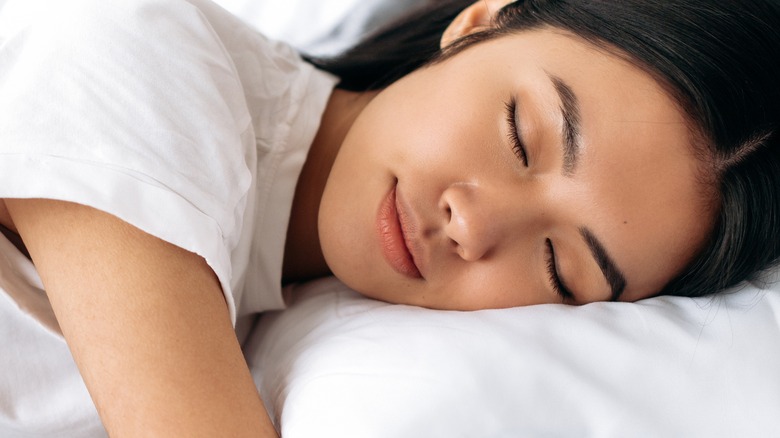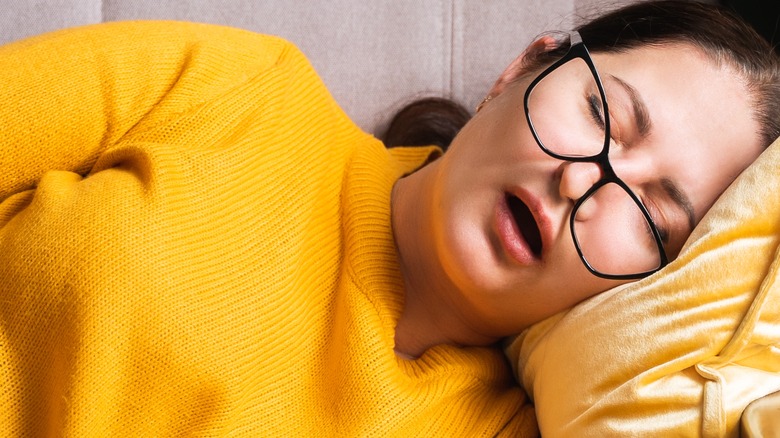Can The Way You Sleep Really Cause Wrinkles?
We may receive a commission on purchases made from links.
No matter how many cosmetics you use to nourish your skin, getting enough good-quality sleep is an indispensable step in any effective skincare routine. That's why we have the phrase "beauty sleep." When you are in Morpheus' arms, your body increases blood flow, creates more hormones, and repairs skin cell damage so you can wake up with a healthy complexion, per sleep therapist Michael Breus (via WebMD). By the same token, lack of sleep reduces your immune system function, causes dark circles under your eyes, and wreaks havoc on your skin.
Unfortunately, with beauty sleep comes sleep lines. After waking up from a deep sleep, the first thing you see in the mirror, aside from puffiness, are vertical creases and dents splayed across your cheeks and forehead. While it takes only minutes for sleep lines to fade away, repeatedly pleating your skin against your pillow cover can cause wrinkles to form for good. As our body produces less collagen when we age, our skin becomes thinner and sleep lines may stay longer on our face, according to Greene.MD. To achieve youthful skin in the long run, therefore, sleeping right to prevent sleep lines is no less important than getting a good night's sleep. Here are some tips on how you can minimize the formation of wrinkles during your sleep.
Sleeping on your side or your stomach can cause wrinkles
Your sleeping posture is the leading cause of sleep lines. If you have a tendency to sleep on your side or with your stomach or face down, a large part of your face will be pressed into the pillowcase. Prolonged compression of your face against a surface during sleep can result in facial distortion, the formation of creases, and the advancement of an aging appearance, as noted in a study published in the Aesthetic Surgery Journal.
The average human head weighs around five kilograms. Imagine how much pressure your facial skin endures when your face is pressed and rubbed against your pillow for eight hours every day. Besides, squishing your face into the pillow also clogs pores and causes acne breakout, Dr. David E. Bank explains to First Derm. If you see a persistent breakout on certain spots on your face, you'd better make changes to your sleeping habits. To prevent your skin from folding up, you should start training yourself to not sleep on your side, face down, or on your stomach.
Learn to sleep on your back to reduce wrinkle formation
The most optimal sleeping position to avoid sleep lines and permanent wrinkles, by the elimination method, is on your back. According to Murad, this position prevents lines from being etched on your skin and protects your skin from being rubbed against your pillow. Furthermore, you can make an effort to rinse your pillowcases at least once per week to get rid of impurities and dust mites that can cause you major skin issues. Your body exfoliates around 15 million skin cells each night, per Business Insider. Therefore, wash your pillowcases and sheets regularly.
If you can't get used to sleeping on your back through the night anytime soon, you might want to invest in some soft pillowcases such as smooth silk or satin pillowcases instead of cotton or polyester. Smooth and soft sheets can reduce the impact of friction against the skin, help minimize dents on your face, and offer maximum comfort for your sleep. Another thing to keep in mind is to keep your hair away from your face when sleeping to keep the oil and germs in your hair away from your skin. You can tie your hair up, braid it, or swath it in a silk wrap.
Switching sleeping position will help your skin from folding up and looking aged faster than it should. However, your skin also needs a proper diet, consistent skincare routine, and sufficient sleep to look its best.


